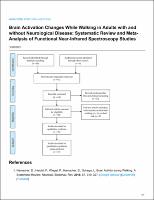Please use this identifier to cite or link to this item:
https://hdl.handle.net/20.500.12202/9367| Title: | Brain activation changes while walking in adults with and without neurological disease: Systematic review and meta-analysis of functional near-infrared spectroscopy studies |
| Authors: | Holtzer, Roee Bishnoi, Alka Hernandez, Manuel E. 0000-0001-6639-0724 |
| Keywords: | neuroimaging dual-task walking neurological disorders |
| Issue Date: | 2021 |
| Publisher: | MDPI |
| Citation: | Bishnoi, A., Holtzer, R., & Hernandez, M. E. (2021). Brain activation changes while walking in adults with and without neurological disease: Systematic review and meta-analysis of functional near-infrared spectroscopy studies. Brain Sciences, 11(3), 291. https://doi.org/10.3390/brainsci11030291 |
| Series/Report no.: | Brain Sciences;11(3) |
| Abstract: | (1) Functional near-infrared spectroscopy (fNIRS) provides a useful tool for monitoring brain activation changes while walking in adults with neurological disorders. When combined with dual task walking paradigms, fNIRS allows for changes in brain activation to be monitored when individuals concurrently attend to multiple tasks. However, differences in dual task paradigms, baseline, and coverage of cortical areas, presents uncertainty in the interpretation of the overarching findings. (2) Methods: By conducting a systematic review of 35 studies and meta-analysis of 75 effect sizes from 17 studies on adults with or without neurological disorders, we show that the performance of obstacle walking, serial subtraction and letter generation tasks while walking result in significant increases in brain activation in the prefrontal cortex relative to standing or walking baselines. (3) Results: Overall, we find that letter generation tasks have the largest brain activation effect sizes relative to walking, and that significant differences between dual task and single task gait are seen in persons with multiple sclerosis and stroke. (4) Conclusions: Older adults with neurological disease generally showed increased brain activation suggesting use of more attentional resources during dual task walking, which could lead to increased fall risk and mobility impairments. |
| Description: | Scholarly article / Open access |
| URI: | https://www.mdpi.com/2076-3425/11/3/291 https://hdl.handle.net/20.500.12202/9367 |
| ISSN: | 2076-3425 |
| Appears in Collections: | Ferkauf Graduate School of Psychology: Faculty Publications |
Files in This Item:
| File | Description | Size | Format | |
|---|---|---|---|---|
| Holtzer 2021 OA mdpi.com-Brain Activation Changes While Walking.pdf | 295.2 kB | Adobe PDF |  View/Open |
This item is licensed under a Creative Commons License

